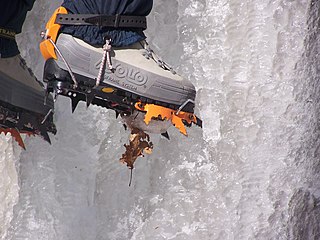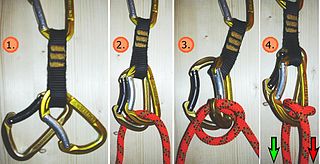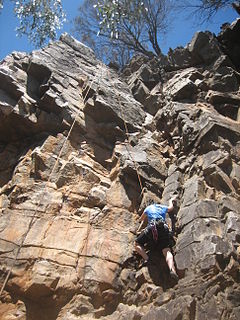 W
WThis glossary of climbing terms is a list of definitions of terms and jargon related to rock climbing and mountaineering. The specific terms used can vary considerably between different English-speaking countries; many of the phrases described here are particular to the United States and the United Kingdom.
 W
WThe Abalakov thread, also known as a V-thread, A-thread, or 0-thread, is an ice protection technique named after its innovator, Soviet climber Vitaly Abalakov. The Abalakov thread is a common method of protecting oneself while ice climbing because it is easy to create, does not require the sacrifice of expensive gear, and can be very safe when used properly. An Abalakov thread is often used in multi-pitch ice climbing routes. Because of its safety and convenience, the Abalakov thread is considered one of the most significant innovations in ice climbing. It significantly expanded the scope of possible routes and abseiling safety.
 W
WAbseiling, also known as rappelling, is a controlled descent off a vertical drop, such as a rock face, using a rope.
 W
WAustralian abseiling is the process of descending a fixed rope in a standing position while facing the ground.
 W
WAn autoblock is a rope device used in climbing and caving for both rappelling (downward) and ascending (upward).
 W
WBelaying is a variety of techniques climbers use to create friction within a climbing system, particularly on a climbing rope, so that a falling climber does not fall very far. A climbing partner typically applies tension at the other end of the rope whenever the climber is not moving, and removes the tension from the rope whenever the climber needs more rope to continue climbing.
 W
WBottled oxygen is oxygen in small, portable, high pressure storage cylinders, as used for high-altitude climbing. Bottled oxygen may also be for a breathing gas, especially for scuba diving or during surgery.
 W
WFast-roping, also known as Fast Rope Insertion Extraction System (FRIES), is a technique for descending a thick rope. It is useful for deploying troops from a helicopter in places where the helicopter itself cannot touch down. Fast roping is particularly useful for marines, who can use the technique to board ships at sea as well as to reach destinations on land. It is quicker than abseiling (rappelling), although more dangerous, particularly if the person is carrying a heavy load, because the rope is not attached to them with a descender. The person holds onto the rope with gloved hands and feet and slides down it. Several people can slide down the same rope simultaneously, provided that there is a gap of approximately 3 metres (9.8 ft) between them, so that each one has time to get out of the way when they reach the ground.
 W
WIn mountaineering, a fixed rope or fixed line is the practice of fixing in place bolted ropes to assist climbers and walkers in exposed mountain locations. They are used widely on American and European climbing routes, where they may be called via ferrata routes, but are not used in "Alpine style" mountaineering. Many guided expeditions to any of the eight-thousanders normally set up fixed rope on steep or icy sections of the route. For example, on the Hillary Step of Mount Everest, fixed rope was used to reduce the bottleneck of climbers that typically results from climbing this technical section just below the summit.
 W
WFront pointing is a fundamental technique in mountaineering and ice climbing which is used to ascend moderate to steep ice slopes. Also referred to as the German technique, it is accomplished through the use of crampons with two front-slanting points or spikes, which allow traction to be concentrated at the toe of the climber's boots. Climbers generally pick up this technique rather easily as it feels natural and secure but have a tendency to overuse it on moderately angled slopes where an alternate technique called flat-footing would be less tiring and just as secure.
 W
WThe Garda Hitch is a class of climbing knots known as ratcheting knots for their ability to let the rope move in one direction, but not in the other. This class of knots has many uses in climbing and mountaineering, for example in a pulley system where a load is being hauled up a cliff, the Garda hitch prevents the load from slipping when the pulley system is reset.
 W
WLead climbing is a climbing style, predominantly used in rock climbing. In a roped party one climber has to take the lead while the other climbers follow. The lead climber wears a harness attached to a climbing rope, which in turn is connected to the other climbers below the lead climber. While ascending the route, the lead climber periodically connects the rope to protection equipment for safety in the event of a fall. This protection can consist of permanent bolts, to which the climber clips quickdraws, or removable protection such as nuts and cams. One of the climbers below the lead climber acts as a belayer. The belayer gives out rope while the lead climber ascends and also stops the rope when the lead climber falls or wants to rest.
 W
WPole climbing is ascending a pole which one can grip with his or her hands. The related activity of mast climbing describes ascending an object similar to a pole, but having a larger diameter which excludes gripping with the hands. In either case, it is normally assumed that climbers who view the activity as a gymnastic sport use only their bodies and limbs, without artificial aids.
 W
WIn sport climbing, redpointing is free-climbing a route, while lead climbing, after having practiced the route beforehand. Many climbers will frequently try to redpoint a route after having failed to on-sight or flash it, although occasionally a climber will forgo an onsight attempt if they suspect that the route is so difficult that an attempt would be pointless. Redpointing differs from headpoint, in that it is exclusive to sport routes with protection equipment fixed into the rock at regular intervals.
 W
WSingle-rope technique (SRT) is a set of methods used to descend and ascend on the same single rope. Single-rope technique is used in caving, potholing, rock climbing, canyoning, roped access for building maintenance and by arborists for tree climbing, although to avoid confusion in the tree climbing community, many have taken to calling it "stationary" rope technique.
 W
WThe South African Abseil or South African Double Roped Classical Abseil is a modern variation of the non-mechanical classical abseil method used by mountaineers and rock climbers to quickly descend steep terrain by sliding down a rope wrapped around their body to create controlled friction.
 W
WSpotting is a technique used in climbing, especially in bouldering, where the climbers are close to the ground and ropes are not normally used. The spotter stands below the climber, with arms raised or at the ready. If the climber falls, the spotter does not catch the climber, but redirects the climber's fall to land safely on a bouldering mat. At the very least the spotter ensures that the climber's head and back do not strike the ground directly. If the climber jumps down, the spotter can also help prevent stumbles and injuries on uneven ground. The spotter should stand with fingers together to avoid broken fingers.
 W
WTop rope climbing is a style in climbing in which the climber is securely attached to a rope which then passes up, through an anchor system at the top of the climb, and down to a belayer at the foot of the climb. The belayer takes in slack rope throughout the climb, so that if at any point the climber were to lose their hold, they would not fall more than a short distance.
 W
WTraditional climbing, is a style of rock climbing in which a climber or group of climbers place all gear required to protect against falls, and remove it when a pitch is complete. Traditional bolted face climbing means the bolts were placed on lead and/or with hand drills. The bolts tend to be much farther apart than sport climbs. For example, a trad bolted route may have bolts from 15–75 feet apart. A sport route may have bolts from 3–10 feet apart, similar to a rock climbing gym. The term seems to have been coined by Tom Higgins in the piece "Tricksters and Traditionalists" in 1984. A trad climber is called a traditionalist.
 W
WA Tyrolean traverse is a method of crossing through free space between two high points on a rope without a hanging cart or cart equivalent. This is used in a range of mountaineering activities: rock climbing, technical tree climbing, caving, water crossings and mountain rescue. A zip-line is in essence a Tyrolean traverse which is traveled down quickly with the assistance of gravity. Several sources claim that the name comes from the Tyrolean Alps, where climbers are said to have developed the system in the late nineteenth and early twentieth centuries.